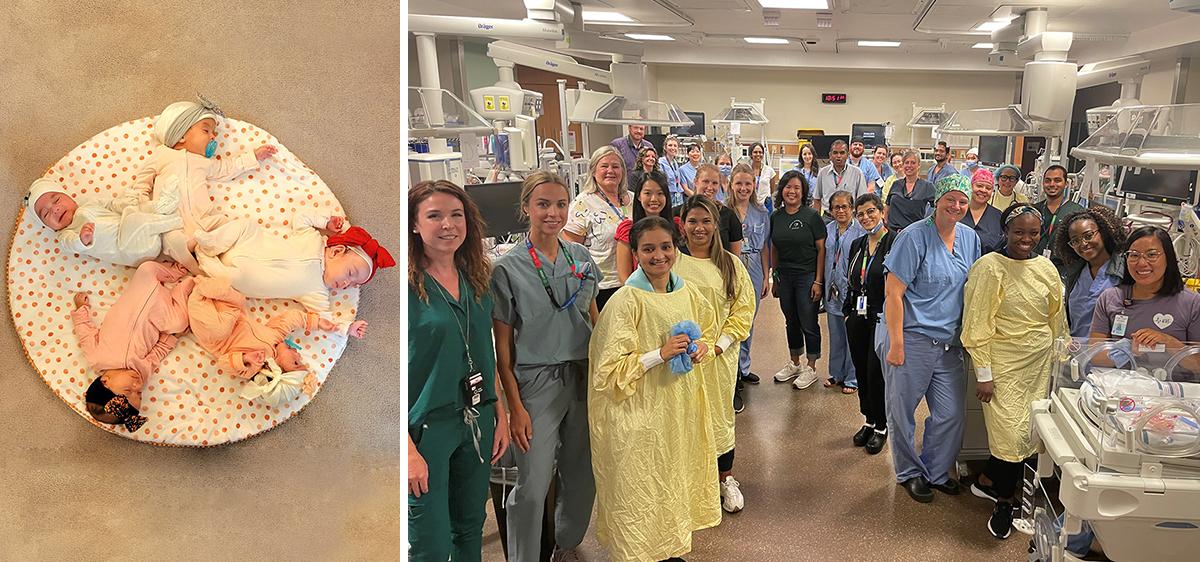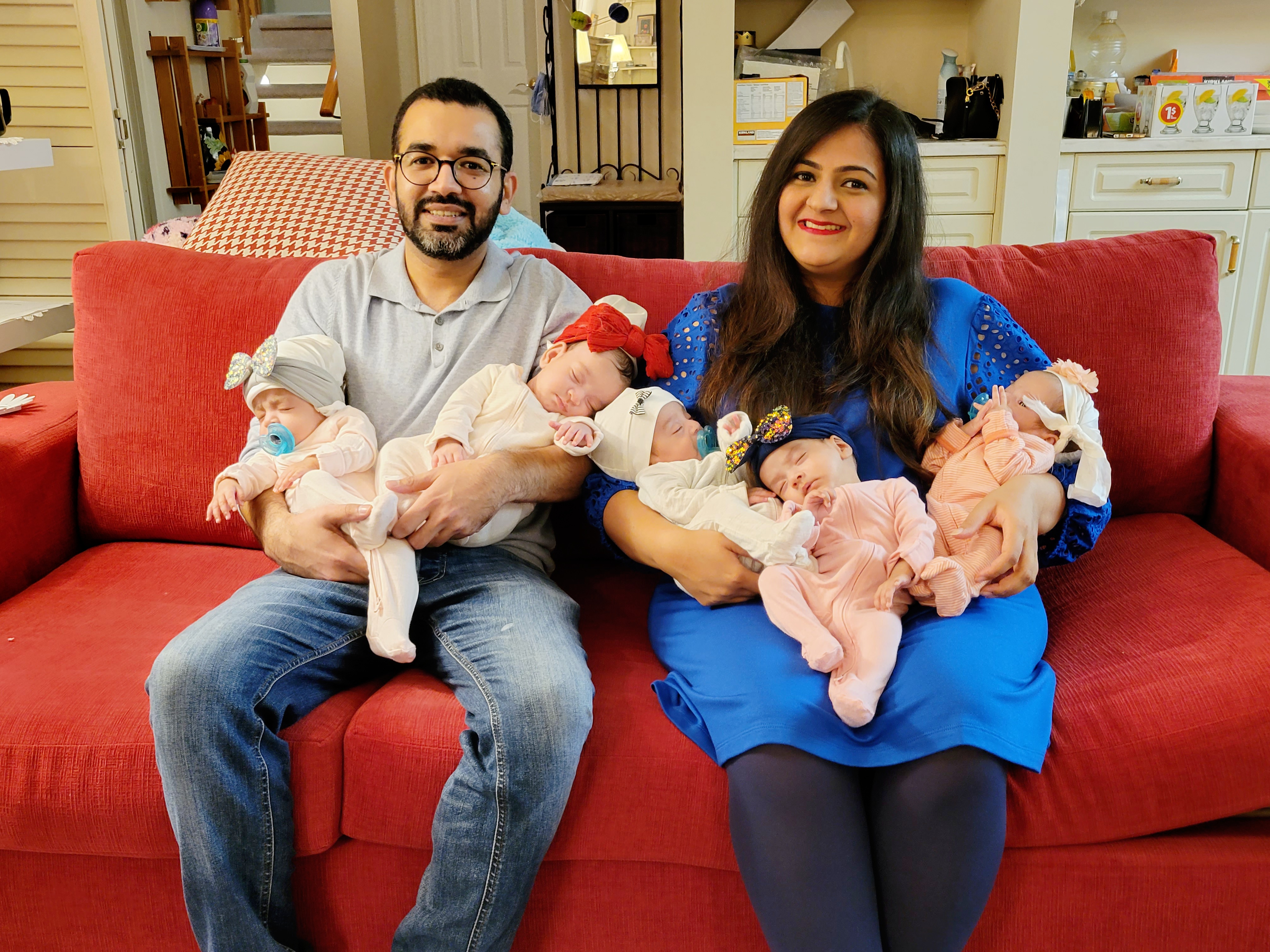Mount Sinai welcomes quintuplets for the first time in more than thirty years

Maria and her husband wanted to start a family but were waiting for the “right time” in their lives. When they found out they were expecting, they could have never expected that they would soon be first-time parents, times five.
When this was confirmed at their first ultrasound, the couple felt a range of emotions – understandable, considering the rare circumstances. From that moment, the space within their hearts filled with the love they already felt for their five unborn babies.
Given the high-risk nature of her pregnancy, Maria was referred to the Ontario Fetal Centre (OFC). A cornerstone of the OFC is its multidisciplinary approach to care and the ability to provide advanced care to some of the highest-risk pregnancies.
Mapping out babies in the womb
The initial anatomy assessment took over four hours (and required lots of breaks) to complete. They measured each fetus, assessing growth and development markers and detecting for any fetal abnormalities.
“It’s already a big feat to do an anatomy assessment, let alone for five comprehensive fetal anatomies,” says Dr. Johannes Keunen, Maternal Fetal Medicine Specialist at the OFC. “As the pregnancy progresses, the babies can be lying on top of each other, which creates challenging barriers to visibility.”
For this reason, each baby was assigned a number in the womb and the team mapped out where each baby was located for ease of tracking at each visit.
It takes a village
There was no sugar coating it that Maria likely would not reach full term. Carrying multiples is associated with a higher likelihood for preterm labour and for complications like preeclampsia. However, thanks to advancements in modern medicine, survival rates for babies born at this gestation are much higher today.
“Our team chose a specific delivery date and time because we had to ensure that a dedicated operating room would be available, in case the procedure would be done in an emergency fashion,” says Dr. Keunen.
Developing a care plan for Maria was a complex, collaborative process requiring thoughtful analysis of maternal and fetal considerations to determine the recommendations for delivery and birth.
“The primary focus was on ensuring appropriate care and the safe delivery of each baby,” says Natalie Lu – the Clinical Nurse Specialist responsible for Maria’s care planning. ”From the beginning there was a lot of planning with the team to determine the ideal time of delivery, which required the organization of essentially five teams to prepare.”
A taskforce of a total of roughly forty individuals was assembled – a team for each baby – on standby for the delivery date.
Unique to Mount Sinai is the ability for Respiratory Therapists to attend the delivery if needed, as an extra support; a critical factor to providing optimal obstetrics and neonatal support.
The many layers of care
Considering that she was carrying five babies, Maria recalls that she was “relatively comfortable” throughout her pregnancy – with the exception of some pokes and prods in her diaphragm and ribs.
“My care team at Mount Sinai brought such a peace of mind to my pregnancy,” says Maria. “I had my own team of cheerleaders in the staff, and I was reassured knowing that if I had any issues during the pregnancy or delivery, I would be taken care of.”
Leading up to the delivery date, Maria and her babies were all doing well.
In those early weeks spent in the neonatal intensive care unit (NICU), Maria recalls each milestone achieved, including increasing their feeds, was met with many celebrations and high fives.
Once the babies were in a stable condition, they were transferred out of Mount Sinai Hospital to a NICU closer to home. The first two quintuplets came home in early September, with the last little one discharged in October. Today, everyone is doing well at home – growing with each day and according to Maria, “making sure their parents are on their toes all of the time”.
“From twenty seven weeks, after every checkup I would get homework to ‘keep the babies in another week’,” jokes Maria. “I was told to eat well, sleep well, and take it easy – doctor’s orders!”
And baby makes…seven
At twenty-nine weeks, Maria was admitted to the hospital when it was discovered that her cervix was shortening. And at thirty-one weeks, she was still doing well, but that was the hard deadline.
Just before the delivery, the entire care team took what Dr. Keunen refers to as a “standardized timeout” – a moment before the procedure to ensure everything and everyone required for the procedure is accounted for.
“This was a nice moment,” reflects Dr. Keunen. “Everyone felt prepared.”
The procedure went smoothly, and on August 3, 2023, the couple welcomed five healthy babies into this world.

In those early weeks spent in the neonatal intensive care unit (NICU), Maria recalls each milestone achieved, including increasing their feeds, was met with many celebrations and high fives.
Once the babies were in a stable condition, they were transferred out of Mount Sinai Hospital to a NICU closer to home. The first two quintuplets came home in early September, with the last little one discharged in October. Today, everyone is doing well at home – growing with each day and according to Maria, “making sure their parents are on their toes all of the time”.











